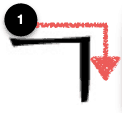Learn to Read Korean in 5 Minutes
In this lesson, you're going to learn the Korean alphabet in only xxx minutes using visual associations, mnemonics, and stories.
That means y'all volition be able to read the Korean alphabet letters A to Z and outset sounding out Korean words anytime you see them. You may be surprised how oftentimes you run across Korean characters!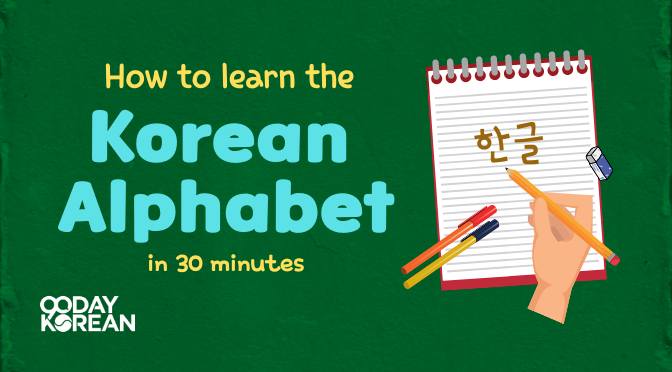
We likewise accept a free PDF version of this Hangul Korean alphabet lesson that you can download here:
You tin print it out and write your answers in the PDF.
We've likewise got a Korean alphabet chart below that has audio samples. If you already know the alphabet, you tin can skip directly to the chart and practise your pronunciation and listening.
Permit'south get to it!
Contents
- i Hangul – The Korean Alphabet
- 1.i Hangul in Korean
- 1.ii Hangul Pregnant
- i.three Hangul Letter Sounds
- two Hangul Nautical chart
- three Korean Alphabet Construction
- 4 How to Learn the Korean Alphabet
- 4.1 The Korean Consonants
- 4.two The Korean Aspirated Consonants
- four.iii The Korean Vowels
- four.iv Reading Korean Words
- iv.5 Korean Double Consonants
- four.6 Korean Double Consonants Pronunciation
- four.7 Korean Vowel Combinations
- 4.viii Korean Alphabet Reading PDF Lesson
- 5 Names of the Korean Letters
- 6 How to Write in Korean
- 6.1 How to Write Korean Messages
- six.2 How to Write Korean Syllables
- 7 English to Korean alphabet
- 8 The Korean Linguistic communication
- 8.1 Hangul Writing Organization
- 8.2 Korean symbols
- 8.three Korean Speakers Worldwide
- 9 Hanja
- 9.i Chinese Characters and Hangeul
- 10 Romanization of Korean Letters
Hangul – The Korean Alphabet
The official writing system for South Korea is Hangul (한글), which is the name for the Korean Alphabet system. That ways you tin say Hangul and Korean alphabet interchangeably since they mean the aforementioned thing.
Korean is the official language of Republic of korea, and information technology uses Hangul as its alphabet and writing system. The same writing system is used in Due north Korea which is called Joseongeul (조선글). Both South korea and North korea use the writing system created by King Sejong the Dandy.
Hangul in Korean
Hangul in Korean is 한글 (hangeul). Hangul is likewise written in English every bit "Hangeul". At that place are 2 dissimilar means of spelling the same discussion. "Hangul" is the most common way, and "Hangeul" is the newer way of writing information technology.
Hangul Meaning
The discussion Hangul comes from the Chinese characters 韓㐎. "Han" means "Korean", and "gul" means "letter of the alphabet". Put them together, and yous've got the term "Korean letter of the alphabet", or "Korean Alphabet".
Hangul Letter Sounds
The Korean alphabet sounds share a lot of similarities to the English alphabet. That makes information technology easy to acquire considering y'all can utilize the English sounds to larn the Korean letter sounds.
The Korean alphabet consists of consonants and vowels that grade syllable blocks. These syllables can be sounded out merely like words in English language.
Hangul Chart
Below is a basic Hangul chart for the consonants and the vowels of the Korean alphabet.
The offset Hangul chart, or Korean alphabet nautical chart, is for the consonants. Next to each of the consonants is the romanized spelling for that particular consonant. The spelling changes depending on whether the consonants are positioned at the starting time or the end of the syllable.
The romanization is only used for thespellingof the Korean word in English letters. If you're learning Korean, or want to know the correct pronunciation, and so you lot should use the associations later on in this lesson and larn the right pronunciation of the Korean alphabet consonants.
Below is a Hangul chart for the vowels of the Korean alphabet. Adjacent to each of the vowels is the romanized spelling of each vowel. The spelling of the vowels is consistent and doesn't change. Notwithstanding, proceed in listen that some people may spell Korean words in English language messages using their ain arrangement.
To have a expert pronunciation of the Hangul consonants and vowels, it'due south best to use the associations below every bit a guide and learn how each letter is correctly pronounced.
Korean Alphabet Structure
Since Hangul is a very scientific alphabet. Information technology's one of the best writing systems for beginners to learn who don't know whatsoever Korean. It'due south too quite easy to write in Hangul since the messages follow a bones order.
Did y'all know that there are fewer letters in the Korean alphabet than there are letters in the English alphabet?
The Korean Alphabet has 14 consonants and x vowels.
Unlike Japanese or Chinese, which have thousands of characters and each tin can accept ten, 15, or more strokes, the almost complex Korean character in the alphabet can exist written using only v strokes. That makes learning both Hangul and Korean quite easy.
On top of this, the Korean language has a grammar structure that can be mastered by understanding some bones rules. This makes Korean a keen language for learning quickly and easily.
Information technology all starts with knowing the Hangul (Korean alphabet) – the basic building blocks of the language.
Hangul is a very scientific writing arrangement. Information technology was developed with precision in mind virtually 500 years ago by King Sejong the Cracking. The Korean writing system before it was created used classical Chinese characters. Only those who are educated are able to read and write using the old Korean writing system. As a result, King Sejong wanted to give Koreans a applied fashion of reading and writing to promote literacy.
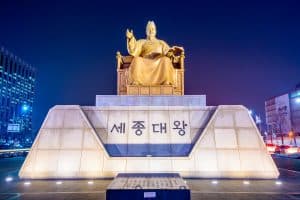
Throughout this page, we'll use the terms Korean letter and Korean character interchangeably. People tend to utilise them both when they learn Hangul, then y'all can employ either i.
How to Learn the Korean Alphabet
This Korean alphabet lesson makes apply of psychological techniques to help make learning Hangul fun and easy. Namely, it uses associations and stories to help everything stick in your brain then you can't forget it.
This lesson covers the Korean alphabet A to Z, broken down and simplified so yous tin begin speaking correct away. There is audio to help your pronunciation with Hangul. The audio looks similar this:
The Korean Consonants
Hangul (the Korean Alphabet) has both consonants and vowels merely like English.
Permit's acquire the consonants in the Korean alphabet to start.
First, allow's have a look at the English alphabet. Instead of looking at the bodily letters, let's only look at the sounds they brand.
In doing and so, nosotros tin can find the closest equivalents in the Korean alphabet so that we can start to make associations to acquire the Hangul messages.
In Korean, there are no F, R, V, or Z sounds, and so let's accept them out.
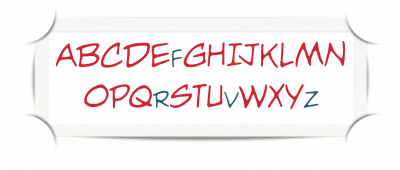
The remainder of the consonant sounds exist in the Korean linguistic communication. However, the Q, W, X and Y sounds must follow one of these two rules:
a) They only can be fabricated by combining two or more sounds (ie., X = One thousand+ S)
For example: The Ten sound can be made by combining the K and S sounds (X = K + Southward). Try it now!
b) They cannot be made without adding a vowel audio afterward (ie., "ya" or "yo")
For example: In Korean, we can create the sounds ya or yo but not the standalone Y sound.
Then let's take these letters out too.

Finally, allow's remove the English vowels since we are offset focusing on the consonant sounds.
How many are remaining in cherry?
13.
But we tin group C and Thou together since, in English, they make the same sound.
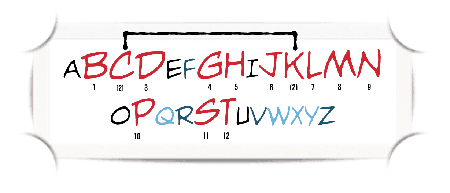
This leaves a total of 12.
Let'southward accept a look at those 12 letters of the alphabet showtime. Since we're learning a new language and accept never seen these shapes before, it will be very difficult for us just to memorize them. Therefore, we need to "link" the characters to something already in our minds in order to create an association.
Let's practice this using a visual learning technique to associate the new messages with pictures and sounds we already know.
The first letter of the English word in the motion-picture show has the aforementioned sound equally the corresponding Korean letter.
This volition assist to start to create associations with Hangul characters.
The Hangul letter of the alphabet ㅂ, which has a audio similar to B in English, looks like a bed with a postal service at either end. Look for a yellow speaker icon followed by the word, and click on the yellow speaker. Hither'southward an example:
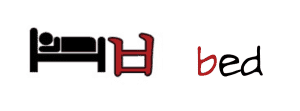
ㅂ
Brand this association in your listen. Write it downwards and commit it to memory.
As well, the Hangul letter ㄷ could seem like a doorframe or the panels on a door. Correspondingly, this letter of the alphabet makes the sound D.
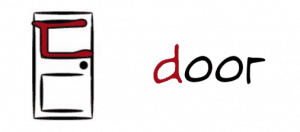
ㄷ
The Korean consonant ㄱ has the advent of a gun and sounds like to an English G. This Hangul alphabetic character is particularly easy to write since it'southward only two lines.

ㄱ
The same goes for the Hangul letter ㅎ(H), which looks like a homo with a lid. You tin can write this consonant every bit a circle with two lines above information technology.
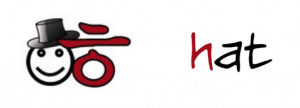
ㅎ
And the consonant ㅈ (J) which could be seen as a jug with a spout at the summit. You can write this Hangul letter a few dissimilar ways, and so just go familiar with the overall shape of the letter.
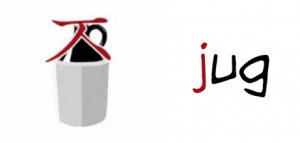
ㅈ
Try creating the associations for these consonant letters now.
Side by side is the Hangul letter ㄹ, which is written using 5 basic strokes and could be compared to the rungs of a ladder. Its sound is well-nigh like to an English language L and can be fabricated the same way by pressing downward with your tongue. This is a fun letter to write!
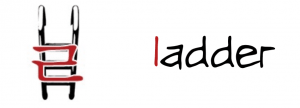
ㄹ
Finally, in that location are the Hangul letters ㅁ, ㄴ, and ㅅ, which have the sounds M, N, and S respectively.
The ㅁ is a square box like a bulletin on a telephone or a piece of mail. You lot can write this consonant like a rectangle.

ㅁ
The Hangul letter ㄴ points up and to the right like a compass pointing to the due north (and the due east at the same time). You tin can write this letter in two lines.

ㄴ
The consonant ㅅ is like a seashell or clam, having but two strokes that slightly overlap. There are ii unlike ways to write this Hangul letter, and then simply get used to the overall shape. Information technology'southward basically just two lines.

ㅅ
Go Korean Alphabet Free PDF Lesson
The Korean Aspirated Consonants
At present we'll learn the aspirated consonants of the Korean alphabet. To practice that, let's take a expect at 4 of the consonant sounds nosotros just learned.
B , D , G, and J .
Make each of these sounds now. "B". "D". "G". "J".
What if we made these consonants stronger, aspirating as we spoke them? What sound would nosotros and so make?
For B , a more aspirated sound forcing out more air would make P sound.
How about D ? It would upshot in a T audio. "T". Try it now.
And K ? A "K" sound, like a C or Chiliad . In English, these two sounds are very similar. Try saying "I've got a cot" five times.
The C is really just an aspirated G.
Finally, if you aspirated a J , it would result in a "ch" audio. Try proverb "inexpensive Jeep" several times and you'll notice how similar the sounds are.
Permit'due south friction match upwards the non-aspirated English language sounds with their aspirated audio pairings.
Come across how similar these sounds actually are?
B — P
D — T
G — M
J — Ch
When we practise the same in Korean, we'll meet some visual similarities in the letters, which tin can assist greatly for the memorization of Hangul characters.
B ㅂ — ㅍ P
D ㄷ — ㅌ T
G ㄱ — ㅋ K
J ㅈ — ㅊ Ch
It's nearly equally if all we did was add a small line to each of those consonants to create the aspirated equivalent.
The adjacent four Korean letters are called the aspirated consonants and are like in sound to their non-aspirated counterparts.
Let's make a visual association too to actually drill in these Hangul letters.
The ㅋ ( Yard ) could be compared to a key. You can write this Hangul letter using three lines.
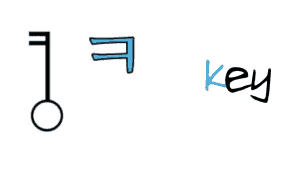
ㅋ
And the Hangul letter ㅌ, which has a "T" sound, could be associated with teeth (similar the ones in your rima oris or the teeth of a fork). You can write this like to the English letter "E."
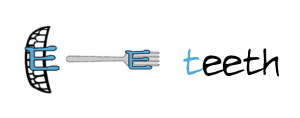
ㅌ
Remember math class? I promise so!
3.14159265359….
What'due south that number? Pi! And the Korean letter with a like sound to P looks very similar to the symbol for pi . That makes it piece of cake to remember. If you lot know how to write pi, then y'all're proficient to go with this letter of the Korean alphabet!
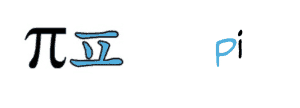
ㅍ
So at that place nosotros have information technology. That's how you lot learn Hangul!
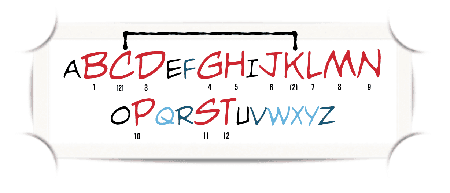
Simply we said at that place were a total of fourteen consonants in the Korean alphabet, so what are the terminal two Hangul letters?
One of the consonants is special because it doesn't have a direct equivalent to an English letter of the alphabet. Instead, it represents a sound in English.
ㅊ, the grapheme representing the "ch" sound in English (" choose"), looks like a church building with a steeple at the top. We can associate this Hangul letter with a church building. Alternatively, we tin can remember it as an aspirated J (ㅈ) and add together an extra line.
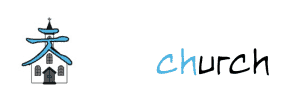
ㅊ
Ok, and so that's thirteen Korean letters already! Y'all're more halfway there.
The last consonant in Korean is really just a placeholder, and makes no sound by itself when placed in front of another character. Yet, it is considered a consonant.
Just like in math, where we use the number 0 equally a placeholder, in Korean, the placeholder grapheme (ㅇ) is a round shape that looks like a zip.

ㅇ
This is a very special character!
It acts as a placeholder and is silent most of the time. After yous learn the Hangul vowels in the next role of this challenge and run across them next to the placeholder graphic symbol, you lot'll know what audio to make based on the vowel.
However, if the placeholder character ends a particular syllable, it is pronounced "ng" like the "-ing" in English.
This is a very of import rule to think. Without information technology, we would be tempted just to skip over the consonant, bold information technology had no sound.
This volition be easier to understand later so it'south best to just make a note of it for now.
The Korean Vowels
In Korean, there are ten basic Hangul vowels that you need to learn. They are the basic building blocks from which you can create all other vowel sounds.
But before we get into that, information technology volition be helpful to practice a basic review of English grammar.
In English, we accept short and long vowel sounds.

All of these vowel sounds be or can be made using Korean letters except for the brusque I audio (this just doesn't exist in Korean and and then is very difficult for Koreans to pronounce).
The letters for the vowels are all pretty piece of cake to learn. No complex shapes hither, simply proficient ol' lines!
The first four Hangul vowels we'll learn are horizontal or vertical lines with a perpendicular line in the middle facing in a particular direction. They look similar this:
ㅗ ㅓ ㅜ ㅏ
The only problem is that nosotros need to recollect which style the perpendicular line points and associate that graphic symbol with the particular Hangul vowel sound.
Allow'due south use a little bit of psychology to learn this part of the Korean alphabet.
First, memorize the following acronym:
One-time iPod, new iPad
A trivial fun fact: did you know the commencement iPod came out in 2001?
That makes information technology old.
The iPad came out in 2010, making information technology comparatively due northew.
Easy correct?
Now heed carefully to the vowel sound in each discussion.
old. Long O audio.
iPod. Short O sound.
northwardew. Long U audio.
iPad. Brusk A sound.
Neat! Let'due south go back to the acronym. We've placed it on a timeline to correspond when each gadget was released.
Recite "Sometime iPod, new iPad" working counterclockwise around the circle.
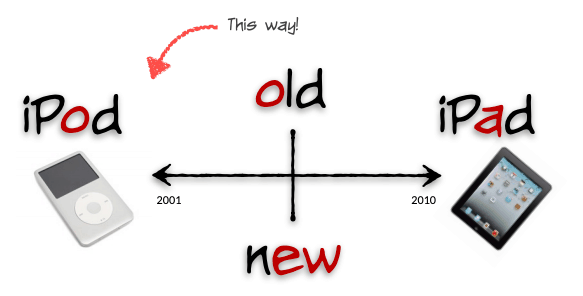
Good piece of work!
Now, all we need to practice is line upwardly the Hangul vowel letters with the respective sounds.
The alphabetic character with the line pointing up is " old" and has the long O sound.
The letter pointing to the left has a short O sound like the O in "iPod," while the letter pointing to the right has a short A sound like the A in "iPad."
Finally, the alphabetic character pointing downwards has a long U sound similar the e-w in "northwardew ."
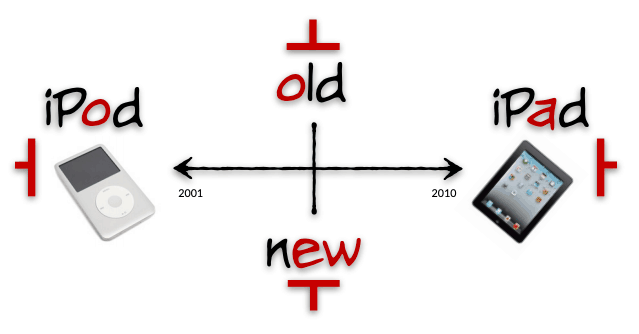
Not too bad so far, right? Commit these vowels to memory and let's continue the momentum going!
Think how nosotros added an extra line to some of the consonants to change the sound and make it aspirated? Well, we can also add a line to the four vowels we simply learned to create new sounds!
You may recall back to the showtime of this challenge when we explained how we couldn't create a Y sound on its ain. But we did say we could if we added a vowel audio afterwards information technology!
Well, we can do just that when we add a line to each of the get-go four vowels. That way, we can simply larn four more of the vowels!
The Hangul vowels we accept learned then far are:
ㅗ ㅓ ㅜ ㅏ
old ipod new ipad
"oh" "aw" "oo" "ah"
We tin can now create the post-obit alphabet sounds by just adding a 2nd line:
ㅛ ㅕ ㅠ ㅑ
"yoh" "yaw" "yoo" "yah"
So, one time you acquire the first four vowels, the second four are really piece of cake. All y'all need to do is double upwards the line and retrieve to add a Y sound in front.
Larn these characters and commit them to retentiveness.
So, there are only 10 Korean vowels and nosotros already know eight of them.
Luckily, we saved the easiest two for concluding. The last two Hangul vowels are merely lines likewise — i horizontal and the other vertical.
The hardest part is just remembering which of the Hangul letters makes which sound.
Luckily we've got some visual associations for that!
We love nature, and these two Hangul vowels do as well.
The outset one is the "tree vowel." Information technology is and so-called (at least by us) because it'due south tall and straight!
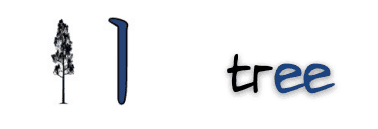
ㅣ
Observe how the double due east in "tree" creates the long E sound. The Korean grapheme with the aforementioned audio (ㅣ) looks similar a tree, making it easy to call up.
And the almost picturesque landscapes are non consummate without a brook. This next Hangul vowel is long and straight just like a beck!

ㅡ
Also, notice the sound the double o in "brook" makes. This is the aforementioned sound the last Korean vowel makes. This vowel (ㅡ) is just a horizontal line.
Reading Korean Words
Just like English, you read Korean left to right, pinnacle to bottom.
However, the Hangul letters stick together, existing within pocket-size invisible "boxes". Each ane of these boxes can have up to four letters.
Each little "box" is considered a Korean syllable. You tin too think of them as syllable blocks.
Instead of reading Hangul straight beyond as we practice in English, we read 1 Korean syllable (or syllable block) at a time. Inside each syllable, we read using the rule left to correct, top to bottom. Then nosotros move to the next syllable block. That's all there is to it!

This is the Korean word for "how-do-you-do." Information technology has v syllable blocks, and each syllable block has two or 3 Korean letters.
In the get-go two-syllable blocks, there are two Hangul letters on the elevation and one on the bottom. Following our rule of left to right, top to bottom, we would read in the order 1, 2, 3 as shown above.
The same goes for the second syllable. But call up, the placeholder character here is ending the syllable and then it would have to be pronounced "ng."
The 3rd, fourth and fifth syllable blocks are more than straightforward and are just read merely left to right.
Then going syllable cake past syllable block, could you decide which society nosotros would read the characters in? Give it a try!

Information technology would look like this if we wrote the numbers in. At present, if nosotros apply the associations we learned earlier nosotros can pronounce the give-and-take!
The word sounds similar "an-nyeong-ha-se-yo" when you read it correctly.
If you've gotten the associations with the Hangul consonants and vowels down pat in the previous sections, you can start to read some Korean words on your ain.
Let's try it out. Give each one a try showtime, then cheque your answers below. Use the associations we made to assistance you out!
How would yous pronounce the words written below? Endeavour reading them aloud. We'll write the pronunciations beneath using romanization so yous can cheque them afterward!
i. 카
two. 너
three. 바보
For the first two, we would but read left to right.
ane. k for primal + a as in iPad = ka. This is the Korean discussion meaning "motorcar."
two. n for northeast + eo as in iPod = neo. This ways "you."
At present, for the tertiary 1, we just read left to right for the first syllable, and so meridian to bottom for the second syllable.
That would brand it:
3. b for bed + a as in iPad plus b for bed + o as in old = babo. This is the Korean word for "fool." If you can read these words already, you are definitely not a 바보!
Great work!
At present, remember the placeholder character ㅇ that doesn't make any audio if placed in front of a vowel? It exists for a special reason!
Syllables (or "boxes") must always start with a consonant, and then have a vowel following it.
Let'south practice a quick recap of the Hangul consonants and vowels:
Hangul base consonants: ㅂㅈㄷㄱㅅㅁㄴㅇㄹㅎㅋㅌㅊㅍ
Hangul base vowels: ㅗㅓㅜㅏㅛㅕㅠㅑㅡㅣ
The ㅇ is a consonant, so that means it tin can beginning a syllable. But retrieve that is silent when information technology does!
Let's effort reading some more difficult words and nosotros tin can practice this rule. If you go stuck, remember to ignore the placeholder if it exists earlier a vowel and just read top to bottom and left to right as y'all normally do!
Ready, let's go for Round 2! Look at the words written beneath. How would you pronounce the following?
4. 오늘
five. 미국
half-dozen. 커피
How did it get? Did y'all remember all of the Hangul letters from the associations we fabricated earlier?
Let'due south check.
4. Did you recollect to ignore the placeholder? Practiced. For the first syllable, o equally in old. Then n for northeast + eu as in broo1000 + l for ladder. Romanized, it is written equally oneul. 오늘 means "today."
5. one thousand for mail + i equally in tree plus g for gun + u as in new + 1000 for gun again. This word is written in romanized English as miguk, and is the Korean give-and-take for "The statesA.".
6. k for key + eo equally in iPod plus p for pi + i as in tree = keopi, the Korean word for "coffee."
Congratulations! If you lot got these, and then yous are now able to read 6 vocabulary words in Korean (and many more!).
Go Korean Alphabet Gratuitous PDF Lesson
Korean Double Consonants
In the alphabet, strong double consonants as well exist.
But the skillful news is that there is no need to acquire any new characters to contain them into our skillset!
When you lot see a double consonant, all you lot need to do is slightly change the way you pronounce it by making it stronger.
We've already associated an English consonant sound with each of the characters we've already learned, so with these, we merely need to double that upwardly.
There are just five of these tense double consonants, and here they are:
The ㄸ is the double ㄷ, and so we'll keep the door association. The D sound will be pronounced stronger, like DD.
The ㅉ volition use the aforementioned J audio every bit does the ㅈ, merely information technology volition be pronounced as a stronger JJ.
We'll utilize the potent GG sound for ㄲ, as well as the gun association.
If yous put two ㅂs next to each other, you'll become ㅃ. We will use the bed association. It volition b pronounced using the strong BB audio.
The ㅆ is like two seashells next to each other. The sound is pronounced similar to a strong SS.
Korean Double Consonants Pronunciation
To pronounce double consonants correctly, all you demand to exercise is tense up your tongue and pronounce the sound with a little more force. Just double information technology up!
For case, let'due south take the double consonant ㅃ. For a moment, imagine a bus was coming quickly and your friend was continuing in the middle of the street.
You lot might yell "Omnibus" really loudly to requite your friend a warning!
Thatb sound when you yell the give-and-take would be more similar to thebb sound of the character ㅃ.
The same goes for the other tensedoubleconsonants.For example:
- 떡볶이 (tteokbokki) – rice cakes in sauce (a type of Korean street food)
- 빨간색 (ppalgansaek) – the color "red"
The tough part is making the pronunciation distinction. The twin consonant is basically the same as the single consonant, except it's said with emphasis. Here is a list of the single consonant sounds, their twin counterparts, and the pronunciation:
If you were going to say the word "상" in Korean, then it would sound like "sang".
If you were going to say the word "쌍" in Korean, then it would sound like "ssang".
The deviation is in the accent and the forcefulness of the "s" sound. The twin consonants audio almost aggressive because they are so precipitous.
Korean Vowel Combinations
If you followed the lesson above to learn Hangul, then you have learned the majority of the Korean alphabet characters. You know the base consonants and vowels, which are the most of import.
Hangul base of operations consonants: ㅂㅈㄷㄱㅅㅁㄴㅇㄹㅎㅋㅌㅊㅍ
Hangul base vowels: ㅗㅓㅜㅏㅛㅕㅠㅑㅡㅣ
In addition to these Hangul letters, there are also 11 additional vowel combinations. These are combinations of the base Hangul vowels you see above.
The Hangeul vowel combinations are:
The kickoff Hangeul vowel is written as a combination ofㅓ(iP o d) + ㅣ (tr ee ) = ㅔ ( east gg). If yous say the "o" sound from "iPod" and the "ee" sound from "tree" together very quickly, it becomes the " eastward " from e gg.
The combined ㅓ+ㅣ doesn't exactly sound like e , but they are similar. Alternatively, you can skip the sound blending and attempt to remember this one as " e gg". Whatever works all-time for you lot!
The 2nd Hangeul vowel combination is written the aforementioned equally the outset, except that we're starting with ㅏ instead of ㅓ. Blend together "iP a d" and "tr ee " and you get e gg, the aforementioned audio as with ㅔ above.
Even though the pronunciation is the same, the romanization spelling is dissimilar. It is done that way so if you lot see the spelling in English, you know which " e gg" is used to spell the word in Korean.
How do I differentiate between the Korean letters ㅐ and ㅔ?
This next Hangeul vowel looks very similar to the ㅔ, except the first of the vowles is written as ㅕ. That means we'll add together the"y" sound to the start. This vowel combination sounds like the beginning of the give-and-take ye s.
The starting time role of this Hangeul vowel combination tin be seen equally the graphic symbol ㅑ (" ya " sound) with the characterㅣ (" ee " sound in tr ee ) written after it. It also sounds like the beginning of ye s.
The Hangeul vowel ㅢ has roots in the ㅡ + ㅣ, then it'due south quite fun to say. It'due south a unique sound, and you demand to pronounce it quickly to get correct.
Blend together the sound ㅡ (br oo k) + ㅣ (tr ee ) and you'll go ㅢ (1000 ooey ). Imagine saying "chop southward uey " really fast.
For this Hangul vowel combination, the audio is "wa." Information technology is similar to the beginning of the give-and-take " wa ffle". It is written equally a combination of the two Korean alphabet letters ㅗ and ㅏ.
This Hangeul vowel combination makes the sound that sounds similar the starting time of the discussion " we dding." It is written by combining the two Korean alphabet letters ㅗ and ㅐ.
This Hangul vowel combination is pronounced the aforementioned as ㅙ, from above. It sounds like " we dding". Information technology is written by putting together the Korean alphabet messages ㅗ and ㅣ.
If you combine the two Korean alphabet letters ㅜ and ㅣ, then you get ㅟ. This Hangul vowel combination sounds like the commencement of the give-and-take " wee thousand".
This combination of Hangul vowels makes a sound like the beginning of the word " wo n". It is written by combining the Korean alphabet letters ㅜ and ㅓ.
When yous combine the 2 Korean alphabet letters ㅜ + ㅔ, y'all get 웨. This Hangul vowel combination has a sound that is the same as the first of " nosotros dding".
The pronunciation of some of the Korean vowel combinations is exactly the same. These vowel combinations can be tricky because they don't follow every bit structured of patterns equally the rest of the consonants and vowels.
We recommend coming up with associations that resonate well with you. You lot may likewise want to endeavour our Hangeul Fabricated Like shooting fish in a barrel form, which is included inside of 90 Twenty-four hour period Korean membership. Within the members' area, we take a full stride-by-step form on Hangul, as well as a structured online Korean class that will teach you lot how to have a 3-minute chat in the first xc days.
Korean Alphabet Reading PDF Lesson
It's pretty amazing, isn't it? You're already well on your style toward learning the Korean Alphabet!
We wanted to make things super easy for y'all to print out and study, so nosotros've created a downloadable Korean Alphabet lesson for you to go along the 90 Minute Challenge toward learning how to read in Korean. It also contains some written activities then you tin practice what you've learned.
Get the free Hangul lesson here, and y'all'll exist reading Hangul everywhere you go!
Become Korean Alphabet Gratis PDF Lesson
Names of the Korean Letters
Each one of the Korean Alphabet consonants and vowels has names. Nosotros'll cover them here in this chart of the alphabet messages then you tin can learn them hands.
Below is a list of the letter names of the Korean consonants.
We've provided the English romanizations of the messages in the alphabet alphabetic character chart. However, they should only be used as a guide. Your pronunciation will be much more accurate if you learn the Hangul characters instead of relying on the romanized spelling.
The vowel names are the sounds they make. Below is the alphabet letter nautical chart for vowels.
The names of the Korean alphabet messages (Korean vowels and consonants) are really useful when you desire to spell out words, or if someone is explaining the spelling of a word. If you're non sure of the spelling, ask for the syllables to exist read slowly, 1 past ane. If you're not certain about the spelling of a syllable, say the characters in the syllable i by one and ask for confirmation.
How to Write in Korean
Now that you lot know how to read Korean, allow's talk about how to write in Korean. Yous can put to employ what y'all already learned with the Hangul writing arrangement.
First, we'll talk about how to write Korean letters individually.
Then once you accept some practise with the Korean messages by themselves, we'll go more than into learning to write Korean words and sentences.
How to Write Korean Messages
Only similar the English alphabet, the Hangul writing system besides has a letter order (stroke gild). While you can get by without information technology, taking the fourth dimension to do will assistance speed up your Korean writing abilities. It'southward also helpful to acquire to write the Korean Alphabet letters if you're going to travel to or live in Korea.
For example, here is how to learn the stroke order for ㄱ:
Try putting your skills to the test by writing Korean words that you hear in Hangeul. You can even practice writing your name in Hangeul by sounding information technology out!
How to Write Korean Syllables
If you want to get good at Korean writing, and so you lot'll demand to know the syllable structure.
Each Korean syllable is fabricated up of at least one consonant and 1 vowel. It's possible to have multiple consonants every bit well. There will simply be a single vowel, but that vowel may be one of the vowel combinations.
Korean syllable blocks can incorporate 2, 3, or iv Korean letters. Here are the combinations:
- 2 letter syllable blocks: Consonant-Vowel
- instance: 가
- 3 letter syllable blocks: Consonant-Vowel-Consonant
- example 갑
- iv alphabetic character syllable blocks: Consonant-Vowel-Consonant-consonant
- example 값
Annotation that 3 and 4 letter syllable blocks have a final consonant or final consonants.
The vowel in the syllable block may be written to the correct of, below, or to the correct and below the initial consonant depending on the vowels.
- To the right of the initial consonant: ㅏ ㅐ ㅑ ㅒ ㅓ ㅔ ㅕ ㅖ ㅣ
- example: 가
- Under the initial consonant: ㅗ ㅜ ㅛ ㅠ ㅡ
- instance: 고
- Both to the right and under initial consonant: ㅘ ㅙ ㅚ ㅝ ㅞ ㅟ ㅢ
- example: 과
English to Korean alphabet
Beneath is a table that will evidence you the English messages with their Korean approximations. This means they're not the exact equivalent so there can exist many other messages that work besides. Information technology depends on the situation.
The Korean alphabet is unique on its own having its own unique sounds. These are only approximations that can yous as y'all begin learning Korean.
We are giving you the 80/20. If you really want to spell a word properly in Korean, you should use a Korean lexicon to observe the correct word.
| English | Korean |
|---|---|
| A in Korean | ㅏ |
| B in Korean | ㅂ |
| C in Korean | ㅋ |
| D in Korean | ㄷ, ㄸ |
| East in Korean | ㅔ,ㅐ |
| F in Korean | ㅍ |
| G in Korean | ㄱ |
| H in Korean | ㅎ |
| I in Korean | ㅣ |
| J in Korean | ㅈ |
| G in Korean | ㄱ, ㅋ |
| 50 in Korean | ㄹ |
| M in Korean | ㅁ |
| Due north in Korean | ㄴ |
| O in Korean | ㅗ, ㅓ |
| P in Korean | ㅂ, ㅍ |
| Q in Korean | ㅋ |
| R in Korean | ㄹ |
| S in Korean | ㅅ |
| T in Korean | ㅌ |
| U in Korean | ㅜ |
| V in Korean | ㅂ |
| W in Korean | ㅝ, ㅟ |
| X in Korean | ㅈ |
| Y in Korean | 예, 얘 |
| Z in Korean | ㅈ |
The Korean Language
Here are a few pieces of useful info about the Korean Alphabet and language. Often in the process of learning the language, y'all'll learn near the culture, and vice versa.
For example, many people may hear near Korean dramas or movies and sentry a few they like. Then they decide they want to understand the phrases, expressions, and dialogues amend without subtitles.
Some other advantage equally you lot acquire Hangul is that you also acquire the correct Korean pronunciation. You'll be able to pronounce Korean words like a native Korean speaker.
Hangul Writing System
Hangul (Korean alphabet) is the official writing system used in both Due north Korean and Republic of korea. Hangul is called 조선글 (joseongeul) in North korea.
They also both use Korean equally the official language, but the variations are a flake dissimilar. The northern version of the language tends to use more Chinese loan words, where the southern version has more English loan words.
Korean symbols
Sometimes the Korean alphabet letters may be referred to as symbols. All the same, information technology's easier to retrieve of them equally characters or letters.
One common Korean symbol is the ₩ for the Korean won, which is the currency in Republic of korea.
Korean Speakers Worldwide
There are nearly 77 million Korean speakers worldwide. According to the National Institute of Korean Language, Korean is the 13th most widely used linguistic communication.
There are many Korean speakers worldwide. Here is the breakdown land by country.
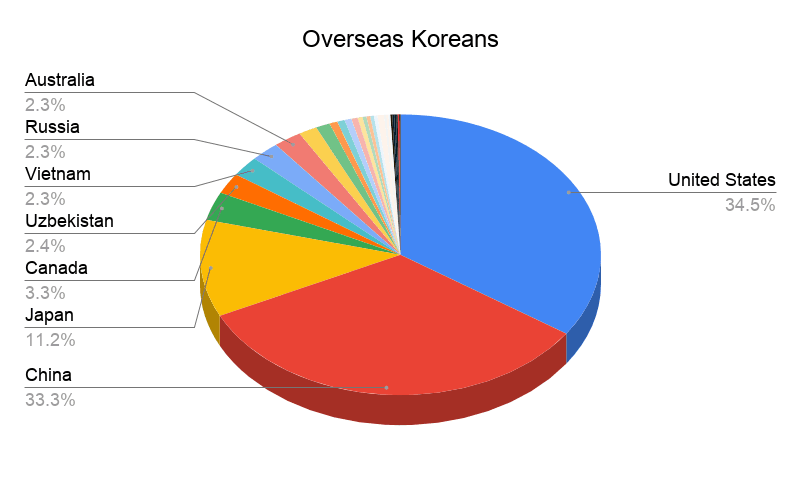
If you want to find native speakers to talk to in Korean, then here are the height countries with overseas Koreans:
| 1. Us | half dozen. Vietnam |
| 2. People's republic of china | 7. Russia |
| 3. Nippon | 8. Australia |
| 4. Canada | 9. Kazakstan |
| v. Uzbekistan | x. Philippines |
Hanja
If you know whatsoever Japanese or Chinese, so y'all might recognize some similarities in the languages. Japanese and Korean share some grammar structures, while some Korean words accept Chinese roots.
한자 (hanja) is the Korean name for Chinese characters. Hanja is too used to refer to Chinese characters that have been borrowed and used in the formation of the Korean language and pronunciation.
Chinese Characters and Hangeul
When reading sentences and signs written with Hangeul (Korean alphabet), y'all may notice that in that location are Chinese characters mixed in with the words. This is mutual in newspapers and some signs in stores. You don't demand to learn Chinese characters to know Korean, but it tin can be helpful.
Some Korean learners have said that knowing Chinese characters accept made it easier to larn the language. That is because many Korean words have roots in Chinese characters. You may desire to supplement your Korean learning with some basic Chinese characters, only information technology'south non necessary.
Romanization of Korean Letters
Writing a Korean discussion in English letters is called "romanization". Each letter in the Korean Alphabet has a corresponding alphabetic character or set of messages.
It's non difficult to learn and it has some common practical uses. For example, you may need to write downwards an address or edifice name in Korea for someone that doesn't know Hangul. In that instance, y'all could write it in romanized Hangul, which would be a proficient approximation.
There are some great tools that you tin utilize for the romanization of Hangul words.
We recommend learning Hangul as fast as possible. The Korean Alphabet will be far more precise compared to romanization. It will greatly aid your pronunciation and Korean language learning speed. You'll be glad you lot did!
How long did it take you to learn to read the six Korean words? Let u.s.a. know in the comments below!
Source: https://www.90daykorean.com/how-to-learn-the-korean-alphabet/
